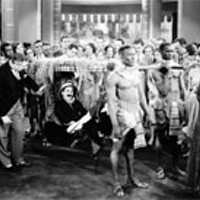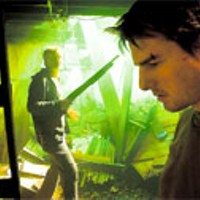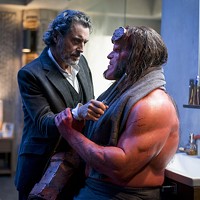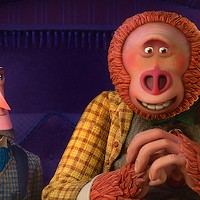

The Basic Plot: Loosely based on the real-life exploits of serial killer Ed Gein (whose sordid tale also served as the basis for Alfred Hitchcock's Psycho), both versions center around five college-age kids whose ill-advised road trip through a desolate part of Texas puts them in contact with a murderous, cannibalistic clan. The family's most terrifying member, tagged "Leatherface," is a silent, hulking psychopath with a nasty habit of peeling off his victims' faces and wearing them as masks.
The Films' Impact: When the original TCM was released in '74, it caught audiences completely offguard. Even coming on the heels of The Exorcist, which did its own share of theater-clearing, this one emerged as a lightning rod of controversy, leading to an abundance of shell-shocked viewers, altercations between moviegoers and theater management, and vilification from many quarters (though, perhaps surprisingly, many of the reviews were favorable, and the film even earned a distinguished berth at Cannes). Like the earlier Night of the Living Dead, the movie succeeded largely because of its gritty, low-budget shooting style, and its influence on subsequent slasher flicks can't be understated (what are Halloween's Mike Myers and Friday the 13th's Jason if not carbon copies of Leatherface?).
The new TCM, however, will ultimately be as influential as Bill Clinton at a GOP fundraiser. With nothing to set it aside from today's typical slasher flick -- and released on the heels of a number of other gore flicks waxing nostalgic about the genre's past (Cabin Fever, House of 1000 Corpses, etc.) -- this Massacre will make its millions at the box office before heading into relative obscurity.
The Gore: It's been repeatedly stated before, but I'll note it again: The original TCM is nowhere near as gory as it's reputed to be; instead, director Tobe Hooper uses the power of suggestion (much as Hitchcock and Jacques Tourneur used to do) to make us think we saw more than we actually did. Most of the murders are swift (shockingly so), and the camera doesn't linger on hacked off heads, blood-spurting limbs, guts spilling out of open stomach wounds, and so on. The same, alas, can't be said for the new version, which not only includes close-ups of various body parts getting chopped off but also offers loving shots of a woman during and after the moment she blows her own brains out, even zooming the camera through the hole in her head! Would it surprise anyone to learn that the film's producer is Michael Bay, better known as the director of this summer's Bad Boys II?
Leatherface: In the '74 take, Leatherface was a terrifying question mark, an unstoppable force of evil who simply existed. With no semblance of a past or a future, we had to accept him at (pun alert) face value -- a mysterious being placed on this earth for no other apparent reason than to carry out Satan's will. The new-but-not-improved Leatherface comes complete with his own backstory. We learn that he suffered from a debilitating disease as a child that ate away at his flesh (we even get to see him without his masks -- "Look, Ma! No nose!"). We learn that he was teased and bullied throughout much of his life. We learn that his favorite TV shows were Gilligan's Island and Hazel. Well, OK, maybe I imagined that last one, but you get the drift: Everything is explained away, as if a screenwriter's idea of pop psychology would enhance the terror rather than diluting it.
The Victims: Part of the appeal of seeing low-budget affairs like Night of the Living Dead or TCM for the first time is that, because there are no name actors attached, we have no idea who will emerge as the hero or heroine from among the ensemble, thus adding to the unpredictability of the piece (this practice changed in the late 70s and early 80s, when filmmakers decided that the character of the "female virgin" was automatically the most worthy of survival). But because the new TCM has a name actor -- Jessica Biel, from TV's 7th Heaven -- we instantly know who's going to make it through the night. That's certainly not a crippling problem, and Biel delivers a perfectly competent performance. In fact, as a whole, all of the actors in the new version are more polished (though not necessarily more interesting) than their somewhat amateurish counterparts from 1974. The major exception is Marilyn Burns, who played the original's last standing survivor. Merely OK during the expository scenes, she eventually turns in a performance of staggering power as her character gets harassed by every member of the clan during the picture's final third. There's a touch of madness to her emoting (at one point when she escapes from Leatherface, it's impossible to tell whether she's laughing or crying, or both), and her wide-eyed terror -- as primal as anything I've ever seen in a motion picture -- remains with you long after the film is over.
The Themes: Frequently dissected in print, the original has (pun alert two) worn many faces over the years, representing the disillusionment of the nation after Vietnam and Watergate; pushing a pro-vegetarian stance by decrying the brutality of eating meat; serving as a bastardization of the image of the all-American family as a wholesome, reliable entity; and further supporting the big-city mindset that views rural America as a haven for in-bred illiterates. The lesson we learn from the remake? Mount an expensive ad campaign so that the bucks will pour in before the word of mouth gets out.
The Bottom Line: The 1974 version is a genuine classic of the genre, a punishing, unrelenting nightmare that never allows viewers even a moment of sanity or security. The 2003 version is nothing more than business as usual, a feeble retelling that guts the integrity of the original and wears its own cynicism like a ragged mask.





